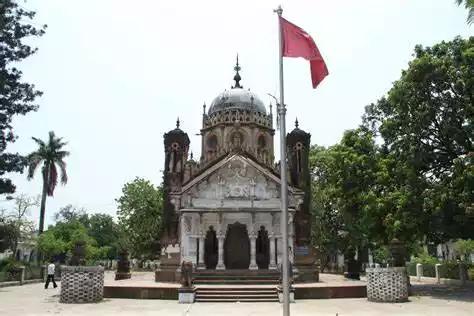Comprehensive Guide to Balrampur-Ramanujganj District
Introduction to Balrampur-Ramanujganj District
Balrampur-Ramanujganj, located in the northern part of Chhattisgarh, India, is a district rich in history, culture, and natural beauty. It offers a unique blend of heritage and modernity, making it an intriguing destination for travelers and researchers alike. This article delves into the various aspects that make this district a noteworthy area.
Geography of Balrampur-Ramanujganj
Location and Topography
Balrampur-Ramanujganj district is situated in the northeastern part of Chhattisgarh, bordered by Uttar Pradesh to the north and Jharkhand to the east. The district encompasses a diverse landscape that includes lush forests, rolling hills, and fertile plains.
Climate
The district experiences a tropical climate with hot summers, mild winters, and a monsoon season that brings substantial rainfall. The climate supports a variety of flora and fauna, contributing to the district's rich biodiversity.
Demography of Balrampur-Ramanujganj
Population
Balrampur-Ramanujganj has a population of approximately 800,000 people. The demographic profile includes a mix of indigenous tribes and people from various cultural backgrounds, creating a diverse social fabric.
Languages
The primary languages spoken are Hindi and Chhattisgarhi, with several tribal languages also prevalent in rural areas. This linguistic diversity reflects the district's multicultural heritage.
Historical Background
Ancient History
The region has a rich history dating back to ancient times. It was once part of the Kosala kingdom, and archaeological findings suggest the presence of early human settlements.
Medieval Period
During the medieval period, the area was influenced by various dynasties, including the Mauryas, Guptas, and later the Kalachuris. The district has several historical sites that testify to its past grandeur.
Modern History
In the colonial period, Balrampur-Ramanujganj came under British rule, and post-independence, it became part of the state of Madhya Pradesh before the formation of Chhattisgarh in 2000. The district itself was officially formed in 2012.
Culture of Balrampur-Ramanujganj
Festivals and Traditions
The district is known for its vibrant festivals and cultural events. Major festivals include Diwali, Holi, and local tribal festivals such as Karma and Sarhul, which are celebrated with great enthusiasm.
Art and Craft
Local artisans are skilled in various crafts, including pottery, weaving, and traditional jewelry making. These crafts are not only a source of income but also a means of preserving the cultural heritage.
Dance and Music
Traditional dance forms like Karma and Saila are integral to the district's cultural identity. Music, often accompanied by folk instruments, plays a vital role in community gatherings and celebrations.
Cuisine of Balrampur-Ramanujganj
Traditional Dishes
The local cuisine is a delightful mix of tribal and mainstream culinary practices. Staple foods include rice, lentils, and a variety of vegetables. Popular dishes include Chana Samosa, Thethri, and local versions of lentil-based dishes.
Unique Ingredients
Local ingredients such as mahua (a type of flower used in sweets and drinks) and various forest products are commonly used in traditional recipes, adding a unique flavor to the cuisine.
Administration of Balrampur-Ramanujganj
Governance Structure
The district is administered by a district collector, who is responsible for maintaining law and order and overseeing developmental activities. The administrative framework includes several sub-divisions and tehsils for efficient governance.
Key Development Initiatives
Recent years have seen various development initiatives aimed at improving infrastructure, education, and healthcare in the district. These efforts are part of a broader strategy to enhance the quality of life for residents.
Economy of Balrampur-Ramanujganj
Agriculture
Agriculture is the primary economic activity, with a majority of the population engaged in farming. The district produces rice, maize, and pulses, along with various fruits and vegetables.
Industries
In addition to agriculture, there are small-scale industries, including food processing, handloom, and handicrafts, contributing to the local economy. Efforts are being made to attract larger industries to boost economic growth.
Tourist Attractions in Balrampur-Ramanujganj
Natural Beauty
The district boasts numerous natural attractions, including picturesque landscapes, dense forests, and serene rivers. Popular spots include the Rakasganda Waterfall and Semarsot Wildlife Sanctuary, which are havens for nature lovers.
Historical Sites
Historical sites such as the ancient temples and archaeological ruins offer a glimpse into the district's rich past. The Mahamaya Temple and the ruins of the old fort at Ramanujganj are particularly noteworthy.
Conclusion
Balrampur-Ramanujganj is a district that embodies the spirit of Chhattisgarh with its rich cultural heritage, diverse population, and vibrant traditions. Whether you are a history enthusiast, nature lover, or cultural explorer, this district offers something for everyone. The ongoing development efforts promise a bright future, making Balrampur-Ramanujganj a region worth visiting and studying.
By providing a comprehensive overview of Balrampur-Ramanujganj, we hope to highlight the district's unique attributes and encourage further exploration and appreciation of this remarkable area.
